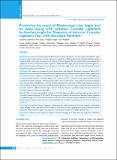Please use this identifier to cite or link to this item:
https://hdl.handle.net/20.500.14356/1460| Title: | Predictive Accuracy of Blumensaat Line Angle and Its Apex along with Anterior Cruciate Ligament Inclination Angle for Diagnosis of Anterior Cruciate Ligament Tear with Abundant Remnant |
| Authors: | Adhikari, Vijayendra Joshi, Amit Singh, Nagmani Pradhan, Ishor |
| Citation: | AdhikariV., JoshiA., SinghN., & PradhanI. (2021). Predictive Accuracy of Blumensaat Line Angle and Its Apex along with Anterior Cruciate Ligament Inclination Angle for Diagnosis of Anterior Cruciate Ligament Tear with Abundant Remnant. Journal of Nepal Health Research Council, 18(4), 604-609. https://doi.org/10.33314/jnhrc.v18i4.2939 |
| Issue Date: | 2020 |
| Publisher: | Nepal Health Research Council |
| Article Type: | Original Article |
| Keywords: | Anterior cruciate ligament Magnetic resonance imaging ACL blumensaat line angle ACL inclination angle |
| Series/Report no.: | Oct-Dec, 2020;2939 |
| Abstract: | Abstract Background: Anterior Cruciate Ligament Blumensaat line angle and Anterior Cruciate Ligament Inclination angle can be measured when Anterior Cruciate Ligament is visualized on Magnetic Resonance Imaging. Both these angles can be helpful to determine the intactness of Anterior Cruciate Ligament. The aim of this study was to evaluate the diagnostic accuracy of Anterior Cruciate Ligament - Blumensaat line angle, apex of Anterior Cruciate Ligament - Blumensaat line angle and Anterior Cruciate Ligament - Inclination angle to determine the status of Anterior Cruciate Ligament in terms of tear or no tear. Methods: We conducted a prospective observational study with Magnetic Resonance Imagings of knees of 71 patients, who were divided into Anterior Cruciate Ligament tear and Anterior Cruciate Ligament intact groups based on Anterior Cruciate Ligament - Blumensaat line angle (<150- intact; ? 150 – torn Anterior Cruciate Ligament), Anterior Cruciate Ligament - Inclination angle (>450 – intact ACL; ? 450 – Anterior Cruciate Ligament tear) and apex of Anterior Cruciate Ligament - Blumensaat line angle ( apex towards femur – Intact Anterior Cruciate Ligament; apex towards tibia or parallel lines– Anterior Cruciate Ligament Tear) measured on MRI study. Diagnostic accuracy was calculated in terms of sensitivity, specificity, positive predictive value and negative predictive value of Anterior Cruciate Ligament - Blumensaat line angle, Anterior Cruciate Ligament - Inclination angle and apex of Anterior Cruciate Ligament - Blumensaat line angle. Results: The sensitivity and specificity of Anterior Cruciate Ligament - Blumensaat line angle to detect Anterior Cruciate Ligament status was 95.83% and 95.35% respectively. Similarly, the sensitivity of Anterior Cruciate Ligament - Inclination angle was 95.83% and specificity was 95.35%. The sensitivity of Apex Anterior Cruciate Ligament - Blumensaat line angle to detect Anterior Cruciate Ligament tear on MRI was calculated to be 95.74% and a specificity of 87.5% Conclusions: Anterior Cruciate Ligament - Blumensaat line angle and Anterior Cruciate Ligament - Inclination angle is highly sensitive and specific for the diagnosis of Anterior Cruciate Ligament tear. Apex of Anterior Cruciate Ligament - Blumensaat line angle is also helpful in determination of Anterior Cruciate Ligament tear. Keywords: Anterior cruciate ligament; magnetic resonance imaging; ACL blumensaat line angle; ACL inclination angle |
| Description: | Original Article |
| URI: | http://103.69.126.140:8080/handle/20.500.14356/1460 |
| ISSN: | Print ISSN: 1727-5482; Online ISSN: 1999-6217 |
| Appears in Collections: | Vol. 18 No. 4 (2020): Vol. 18 No. 4 Issue 49 Oct-Dec 2020 |
Files in This Item:
| File | Description | Size | Format | |
|---|---|---|---|---|
| 2939-Manuscript-19986-1-10-20210122.pdf | Fulltext Download | 651.94 kB | Adobe PDF |  View/Open |
Items in DSpace are protected by copyright, with all rights reserved, unless otherwise indicated.
